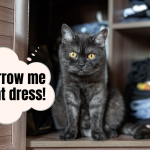Living a cat-and-dog life? Interspecies relations of cats and dogs don’t necessarily have to be associated with constant at-home pursuits and the cat choosing to live above the ground, afraid of a run-in with the dog mouth. With a proper introduction of animals into your home, making sure all their needs are met and that everyone is socialised properly, cat and dog relationships can go great. But there are things that it’s better to take care of before you make the decision to house two such similar, but yet so different species under your roof. What should you be especially aware of?
Can cats and dogs get along?
It’s definitely a key question to ask and it doesn’t have a straightforward answer. You can’t simply throw all the cats and dogs into one basket and treat them as one. Because though a cat can get along with a dog, not all cat-dog duets will be a great match. Why?
One of the biggest things that matters here are the individual predispositions of a particular cat and a particular dog, as well as how the animals were prepared for socialisation, what their lifestyles are, and how the matter is approached by their Carer. When deciding to take in a cat and a dog under your roof, you have to be aware that dogs can have a natural instinct to chase cats around and that cats can have a strong need to protect their territory. Each one can also be better or worse suited for a social life – be the typical individualist who wants to have the hooman and the house for themselves, or, on contrary, be the social butterfly who benefits from having a cat or dog buddy and will take pleasure in spending time together.
The whole thing is also impacted by the stage of life your cat or dog is in – it’s not often that a kitten and a puppy are brought home together, at roughly the same age, both having previous experiences with friends of the other kind and well prepared for living in a multicultural group. So if the cat has been living alone their whole life, accepting a new dog (or cat) buddy may be difficult for them. And if a dog had some bad experiences with cats before or never met a cat at all, their approach to a new cat friend may not turn out as you’d like it to.
Summing up – cats and dogs can get along just fine, but there are many factors impacting their relationships and there’s no way of saying with a 100% certainty that a cat+dog combo will always work out.
Introducing a cat into a dog home or a dog into a cat home – how to start the process?
The number one rule which, according to behaviourists, should be known to everyone who’s planning on bringing another pet home is to focus, first and foremost, on those animals’ well being and their species-specific needs. Unfortunately, the decision to take a cat or a dog home is rooted in wanting to give a companion to a pet already living at home or, what’s equally as common, it’s based on the person’s desire to take care of both a cat and a dog. But do the resident pet really need and want a friend? And will they be able to get along?
For the sake of this article, let’s say we want to adopt a dog into a home and we already live with a cat. We know the cat’s preferences and behaviour well, because they’ve been living with us for at least a few months and they’re well established in their environment. How to prepare for such a mission CATpossible? There’s a few key aspects:
- What’s the dog’s background? Is it your partner’s dog and they know the dog’s behaviour well? Or maybe a dog from a dog breeder, who had some experience with both cats and dogs as a puppy and is generally keen on meeting new friends? Or maybe it’s a rescue dog with an unknown past? Each of those scenarios will make the socialisation process much different and, what’s most important, it won’t always be a success.
- Is the cat sociable or antisocial? If they’ve been living alone for a few years and don’t know the feeling of sharing their space with another pet, introducing them to a dog will require some finesse, caution and respect for the cat’s need to control the environment.
- Is there a chance of introducing the pets gradually, without making them coexist 24/7 from the first minute they meet?
- If any problems occur, is the Carer ready to use the help of a trained behaviourist, to rearrange their space to make it fit two animals or, in the worst case scenario, to give up on socialising the two and rehoming one of the pets?
If we know that the new dog member of our pet crew is prone to attack cats and is – gently speaking – not keen on cats in general, let’s really consider if adopting them makes sense. Unfortunately, stories like this can end in a tragedy and it’s good to be extremely careful with a topic like this.
Cat and dog introduction – the classic and optimistic scenario
Let’s think positive! We have a cat, we want a dog, all the signs seem to show that there should be no problems with socialising them together. What could an introduction of a dog into a cat house look like?
Scent exchange. Your pets should not be sharing the space with each other all the time from the first minute they meet, but rather be allowed to gradually get used to each other’s company. It’s the same with introducing two cats together and using the socialisation with isolation method. It’s good to make sure that all pets at your home have the ability to stay separated, keep their distance from each other and meet in a controlled environment, e.g. through a screen door and with their Guardian’s present at all times.
First meetings. Staying cautious is a key to success! The first time a cat and a dog meet, it’s worth making sure that the dog is on a leash and can be pulled away from the cat if necessary, but also that the cat has the ability to run away and observe the situation from a safe distance, e.g. from a high shelf.
Training. A good starting point that helps you prepare a dog to meet a cat is obedience training. The ability to call the dog over or do some tricks with them without the dog getting distracted will allow you to take their attention off the cat, even when the meeting doesn’t go 100% smoothly.
Building up self-confidence. The vertical space is a cat’s safe haven and dogs are not allowed there. So, when you’re socialising cats and dogs, it’s important to provide your cat with some sort of vertical space which they can use to stay in the room and observe the newcomer from up high. It will make for the pets’ interactions to be mutually agreed on and you’ll be able to provide both animals with a sense of security, reducing their stress and boosting their self-confidence.
Positive reinforcement. Snacks are the best bargaining card. When a cat or a dog starts to associate the other animal at home with something pleasant – snacks, the chances of them seeing each other as a normal part of everyday life go up. It’s important, however, that the positive reinforcement doesn’t start and end on a full bowl – proper playtime and hooman-pet interactions are equally as necessary to both dogs and cats.
A behaviourists help is highly recommended
Our opinion on asking behaviourists for help doesn’t change – their knowledge, experience and their ability to look at the situation and animal behaviour from an outsider’s and a professional’s point of view is highly valuable. When you’re trying to build a positive relationship between a cat and a dog, it’s good to find a behaviourist who’s experienced in working with both species. However, if that’s not an option, it would be beneficial to work with two specialists at the same time and lead the socialisation process with them working side by side.
Where did that idea come from? Behaviourists can help you set up a plan of introducing a dog into a cat house or, if you’re already past that point and the relationship between your pets is not ideal, a behaviourist can help you find their trigger points and find a way of working through them. You can obviously decide to do the pet introduction on your own, without a specialist’s help, but the chances of building a healthy and long-term relationship between a cat and a dog go up when you know what to do and how to do it from the very beginning.
Dog at home vs the safety of your cat and their accessories
To finish things off, we have a small tip regarding cat beds and scratchers. At myKotty, we’ve always said WHY NOT – you, dear fabCats, have been sending us countless photos of your dogs lounging on a cat’s scratcher or cat beds. And that’s OK! We love seeing that. But it’s worth keeping in mind that a bigger dog could possibly break a LUI scratcher with their weight or, if we’re talking a puppy, they could find it a good fun to chew on the cat scratcher. In cases like this, we do recommend to act quickly and move the scratcher onto a dresser or a window sill – your cat’s will be easily able to get to their favourite spot regardless, but there will be no risk of them finding it in a rough shape 🙂
If you have both cats and dogs at home, feel free to share your stories of introducing them to each other in the comments. We’re very curious about how it went down for you and what is the current relationship between your fluffy friends.




